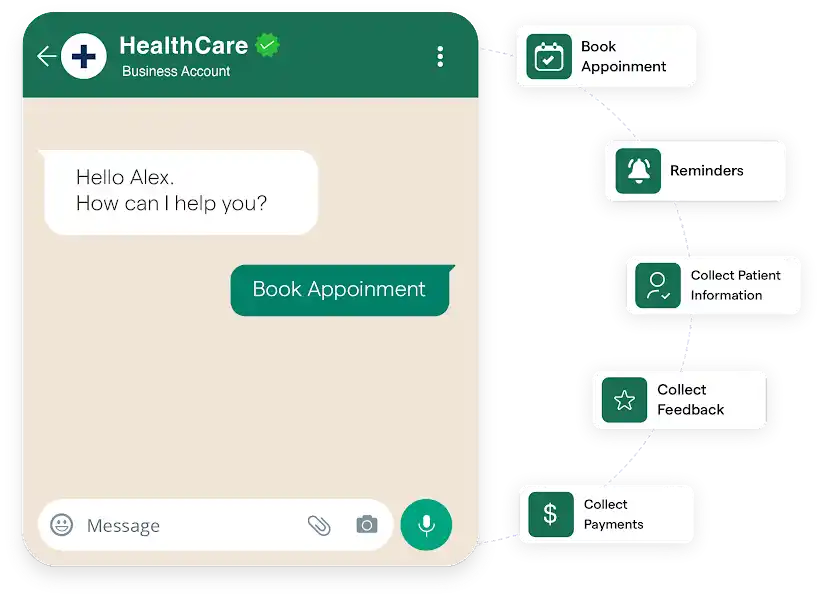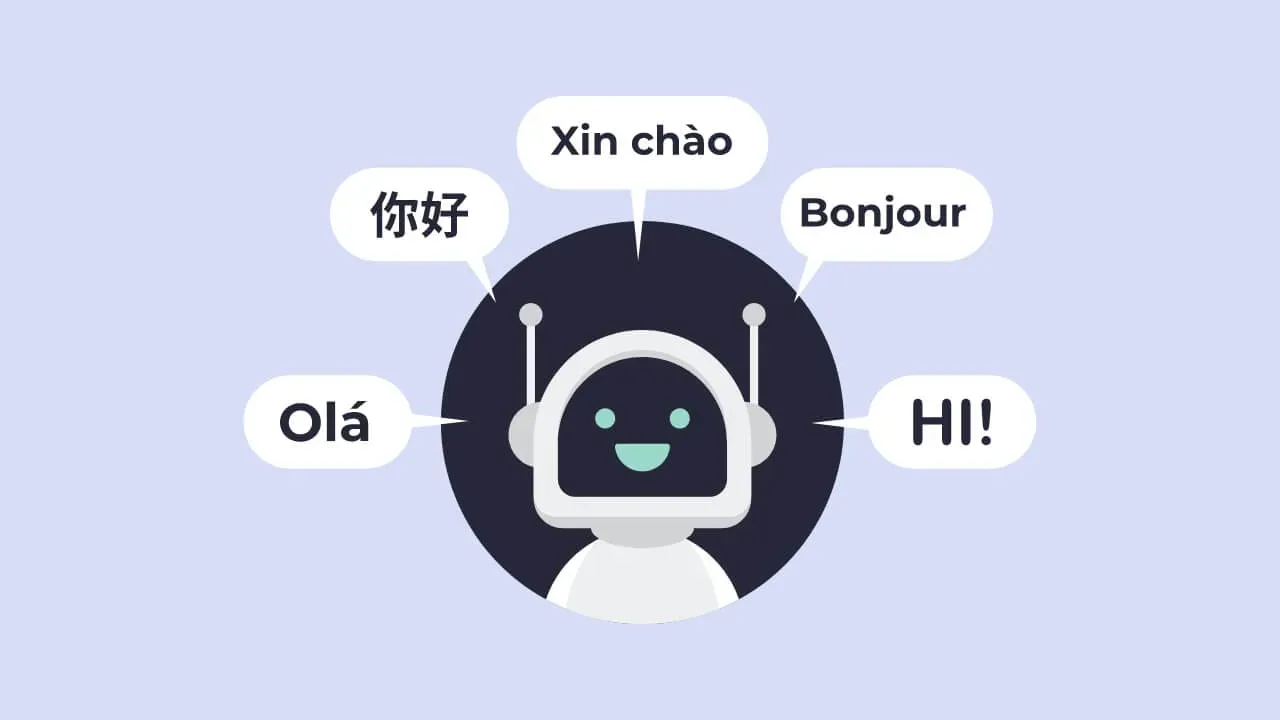Introduction
Hola! Bonjour! Namaste! No matter how you say hello, you want your WhatsApp bot to speak your customers' language, right?
Well, you've come to the right place! Creating a multilingual WhatsApp bot may sound tricky, but We are here to show you how simple it can be.
In this guide, we'll explore how to make your bot a polyglot superstar, able to switch between languages seamlessly.
Imagine the possibilities! Breaking language barriers to engage global audiences and providing top-notch support no matter what tongue your customers speak, the benefits are endless!
From language processing algorithms to user-friendly interfaces, we'll explore the essentials for ensuring your bot resonates with users worldwide. As businesses increasingly embrace the global market, the ability to communicate in multiple languages becomes paramount.
You'll have the blueprint to build bots that chat effortlessly in multiple languages by the end. From "hola" to "namaste," polyglot bots pave the way to global customer connection and commerce.
Intrigued? Well, get ready to dive in! Continue reading on to unlock the power of multilingual WhatsApp bots!
What are WhatsApp Bots?

Before diving into the specifics of building a multilingual WhatsApp bot, it's important to understand the concept of WhatsApp bots and their benefits for business communication.
WhatsApp bots are automated chat systems that can handle various tasks, from answering frequently asked questions to providing personalized recommendations.
Businesses can automate customer interactions, reduce response times, and improve overall efficiency by using bots.
Why Multilingual WhatsApp Bots?
Catering to diverse language preferences is important for any business. By creating a multilingual WhatsApp bot, you can provide a seamless and personalized experience for users of different languages. This enhances customer satisfaction and opens up new opportunities for international expansion and growth.
A multilingual bot allows you to communicate with customers in their preferred language, breaking down language barriers and fostering stronger connections. It's a win-win situation!
How to Create a Multilingual WhatsApp Bot?
Now let us see how to create a Multilingual WhatsApp Bot.
Step 1
Planning a Multilingual WhatsApp Bot

Creating a multilingual WhatsApp bot can increase your audience reach and improve customer engagement. But building one takes careful planning and execution. So do not worry and follow these:
Assessing Target Audience Language Preferences
The first step in planning a multilingual WhatsApp bot is determining which languages your audience speaks.
How? Survey customers, analyze data, or monitor social media channels to see which languages are most commonly used. This will give you a good starting point for your language selection.
Identifying Popular Languages to Include
Once you have a clear picture of your audience's language preferences, identify the most popular languages to include in your WhatsApp bot. This may depend on your business goals and target demographic.
For example, if you target Spanish-speaking individuals, you might prioritize Spanish as a supported language.
Determining the Level of Language Proficiency Required
When planning a multilingual WhatsApp bot, determine the level of language proficiency you need to support.
Do you need a bot capable of handling basic conversations or complex discussions? Understanding this level of proficiency helps you accurately gauge the level of translation and localization work needed for your bot.
Designing the Multilingual Bot Framework

The architecture of your bot needs to be designed with multilingual support in mind. When it comes to structuring your bot for multiple languages, consider these factors:
- Should your bot offers language-specific customization, like using localized images and greetings?
- What back-end requirements are necessary for supporting multiple languages?
Considerations for Handling Language-Specific Customization
Language-specific customization adds a personal touch to your WhatsApp bot. Use images, terms, and phrases unique to each language to enhance user experience.
For example, if you're targeting Japanese speakers, consider incorporating popular Japanese idioms or emojis relevant to the language.
Overview of the Backend Requirements for Multilingual Support
It's essential to understand the back-end requirements for multilingual support. This includes storage and retrieval of language-specific data for your bot.
Some steps involve preparing language-specific content, such as localized messaging, and ensuring your bot can detect and differentiate between languages
Suggested Reading:
Drip Campaign Feature in WhatsApp Chatbot
Gathering and Managing Translations
Translations are crucial in bot communication and ensuring your bot resonates with users. Here are some practices to follow:
- Use strategies for collecting translation in different languages, such as human or machine translation tools.
- Utilize tools and resources to facilitate translation management, including translation platforms or glossaries.
- Follow best practices for maintaining translation consistency, such as memory, where previously translated words are stored for future use.
Now let us see how to Implement Multilingual Support in WhatsApp Bot.
Step 2
Implementing Multilingual Support in WhatsApp Bot

Get ready as we dive into implementing multilingual support so your bot can chat comfortably in multiple tongues. We'll explore how to integrate translation APIs, build a language detection flow, and structure conversations that transition smoothly between languages.
Let's get conversational and implementational in multiple languages!
Configuring Language Detection
Language detection is the first step in providing a personalized multilingual experience. Here's what you need to do:
Techniques for Detecting User Language Preferences
Explore various techniques for detecting the user's language preferences. This can include analyzing the user's device and browser language settings or asking them directly. Consider which method aligns best with the capabilities of your WhatsApp bot.
Language Detection Libraries and APIs Available
There are several language detection libraries and APIs available that can simplify the language detection process. Research and choose the one that best fits your needs. Popular options include the lang detect library and Google Cloud Natural Language API.
Suggested Reading:
WhatsApp Chatbot for Automotive Business
Steps to Implement Language Detection in the Bot
Implementing language detection in your WhatsApp bot involves integrating the chosen library or API into your codebase. Follow the documentation provided by the library or API to ensure accurate language detection. Test your implementation to verify its effectiveness.
Handling Language Switching
Enabling users to switch between different languages within your bot is crucial for a flexible multilingual experience. Consider the following when implementing language switching:
Approaches to Implement Dynamic Language Switching
There are different approaches you can take to implement dynamic language switching:
- One method involves using language-specific buttons or commands that users can interact with to change the language settings.
- Another approach is to allow users to change their language preferences in their account settings.
Considerations for Maintaining Context During Language Changes
When users switch languages, maintaining context is important to provide a seamless experience. Preserve the conversation history and ensure that user input or context is accurately carried over when switching languages. Design your bot's architecture to handle language switching smoothly.
And beginning with WhatsApp bot isn't that tough. Meet BotPenguin- the home of chatbot solutions. With all the heavy work of chatbot development already done for you, set up effective drip campaigns by deploying chatbots for multiple platforms:
- WhatsApp Chatbot
- Facebook Chatbot
- Wordpress Chatbot
- Telegram Chatbot
- Website Chatbot
- Squarespace Chatbot
- Woocommerce Chatbot
- Instagram Chatbot
- MS-Teams Chatbot
- Shopify Chatbot
Step 3
Preparing Language-Specific Content
In this section, we'll explore tips for writing conversational content that connects with users, regardless of the language.
Localizing Bot Messages
Adapt your bot's responses for each supported language. Translate the content while maintaining its original meaning and intent. Consider cultural nuances, idiomatic expressions, and local preferences to create localized bot messages that resonate with users.
Suggested Reading:
Top 7 Ways WhatsApp chatbots can Improve Education
Principles of Writing Effective Localized Messages
When writing localized messages, follow certain principles to ensure their effectiveness. Use simple and clear language, keep sentences concise, and avoid ambiguous terms or cultural references that may not translate well.
Consider the tone and style of communication that aligns with the language and culture you are targeting.
Ensuring Cultural Appropriateness in Localized Content
Localization goes beyond translation; it involves adapting content to specific cultural contexts.
Ensure that your localized messages are culturally appropriate and respectful. Research cultural norms and customs to avoid any accidental misunderstandings or offenses.
Step 4
Testing and Improving the Multilingual Bot

Now it's time to put our multilingual whatsapp bot to the test and refine it for an amazing user experience. In this crucial stage, you will find about the debug issues, assess conversational flows, and gather user feedback across languages.
Test Scenario Creation
Create test scenarios that cover all the supported languages in your bot. Test language-specific features to ensure they function as intended.
Verify the accuracy of language detection and the reliability of language switching. Incorporate user feedback and iterate on your bot to continuously improve its performance.
Incorporating User Feedback in the Bot Improvement Process
User feedback is an invaluable resource for improving your multilingual bot. Encourage users to provide feedback in their preferred language and actively listen to their suggestions.
Use this feedback to address any shortcomings, refine language detection capabilities, and optimize the user experience. Implementing multilingual support in your WhatsApp bot requires careful planning and consideration.
By configuring language detection, handling language switching, preparing language-specific content, and continuously testing and improving your bot, you can create a genuinely engaging and inclusive multilingual bot experience for your users.
Conclusion
In conclusion, crafting a Multilingual WhatsApp Bot demands a strategic blend of linguistic expertise and technological finesse. By embracing a user-centric approach provided in this blog, you can ensure seamless communication across diverse language preferences.
Robust language handling mechanisms, coupled with comprehensive language databases, lay the foundation for a responsive and adaptable multilingual bot. Constant refinement through user feedback and ongoing updates enables the bot to evolve and meet the dynamic linguistic needs of its audience.
As language continues to be a dynamic facet of human interaction, the quest for an effective Multilingual WhatsApp Bot remains a journey of perpetual innovation and adaptation.
But why reinvent the wheel? The master linguists at BotPenguin have already created an incredible multilingual WhatsApp bot to take your global outreach to the next level.
BotPenguin multilingual WhatsApp bot has pre-built polyglot handles automated conversations in over 20+ languages. It transitions seamlessly between tongues to engage users worldwide. And with easy customization options, you can tailor it exactly for your business needs. Integrate your own workflows, customize responses, and make it your own!
Ultimately, by navigating the intricate intersection of language diversity and technological sophistication, you can unlock the full potential of a Multilingual WhatsApp Bot.
Suggested Reading:
Automate your Banking Services with WhatsApp Chatbots
Frequently Asked Questions (FAQs)
What is a multilingual WhatsApp bot and why is it important?
A multilingual WhatsApp bot is a chatbot that can communicate with users in multiple languages. It's crucial for businesses to reach a diverse audience and provide personalized experiences regardless of language barriers, enhancing customer engagement and satisfaction.
How can I create a multilingual WhatsApp bot from scratch?
To create a multilingual WhatsApp bot, you'll need to choose a bot platform, integrate it with WhatsApp's API, implement language detection, and provide language-specific responses using translation APIs or databases.
What programming languages are commonly used to create multilingual WhatsApp bots?
Python, JavaScript, and Node.js are commonly used languages for developing multilingual whatsapp bots. They offer various libraries and tools to support language detection, translation, and integration with WhatsApp.
How do I integrate language detection into my WhatsApp bot?
You can use natural language processing libraries like NLTK or machine learning models to detect the language of incoming messages. Once identified, your bot can switch to the appropriate language for responses.


